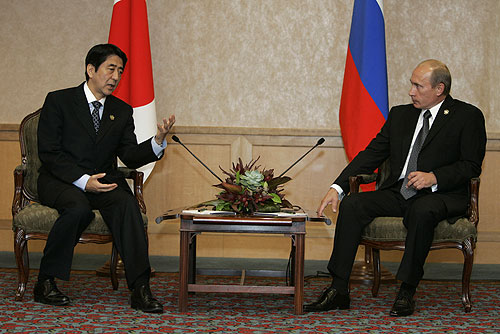Abenomics Moves “All In†with April’s Tax Hike
While March’s wage hike by Japan came as a bright spot amidst growing concern over Abenomics, will April’s 3 percentage point tax hike rain on Abe’s parade?
Since sweeping back into office in December 2012’s Lower House election, Prime Minister Shinzo Abe has pursued an aggressive plan—dubbed Abenomics—to create a “virtuous economic cycle†of increased corporate earnings, wages and consumption.
The first half of 2013 saw Abe’s policies rousing the Japanese economy from two decades of lethargy, resulting in GDP annual growth above 4 percent and a 57 percent surge in the Nikkei 225—its best performance in more than forty years.
While Japan’s economic growth slowed to an annual rate of just 0.7 percent by the fourth quarter of 2013, record corporate profits and business confidence suggested that Abenomics still had some fight left. This notion was supported by wage raises across Japan’s major firms, the outcome of months of lobbying by the traditionally business-oriented Liberal Democratic Party government.
Now Abenomics faces what may be its greatest challenge yet. As of April 1st, Japan has raised its consumption tax for the first time in 17 years from 5 percent to 8 percent. There is active concern that this change could endanger Japan’s fragile recovery, dealing a blow to cash-strapped consumers and nipping business confidence in the bud.
The April tax hike serves a vital, long-term purpose in putting Japan on the path to getting its fiscal house in order. Japan’s public debt, at 240 percent of its GDP, is the worst among industrialized economies. This debt has only grown under the yen-weakening, stimulus-reliant policies of Abenomics, hitting a record high in fiscal year 2014. By raising the consumption tax, the government is expected to take in an additional 4.5 trillion yen ($43.6 billion) in the new fiscal year.
In realizing this goal, however, the Abe government not only faces economic realities, but must also confront economic history in the form of Japan’s last sales tax hike. In 1996, the economy was enjoying what appeared to be a promising recovery from the bursting of a major asset-price bubble in the early 1990s. After the government raised the sales tax to 5 percent in April 1997, however, the economy sank into recession. The downturn would last for over a year and a half, helping deflation take root in Japan.
How much of this downturn was truly the result of the sales tax hike is up for debate. Proponents of the current tax hike say the subsequent recession had more to do with two other incidents in 1997: Asia’s currency crisis and Japan’s own banking turmoil. Opponents argue that the Asian crisis had only limited impact on Japan’s exports and that Japan’s banking sector imploded partly because the tax hike weakened the economy. Regardless of the reality, addressing the latter perception is particularly important given the role of credibility—figurative and literal buy-in—to Abenomics’s success.
The importance of credibility can be seen in the latest tankan report, the Bank of Japan’s survey of over 10,000 companies. Big manufacturers are more optimistic about current conditions than at any time since 2007, and large non-manufacturers are at their most upbeat since 1991. Three months from now, however, big companies from 27 of 30 industries surveyed expect conditions to have worsened.
These forecasting concerns have also played out in the stock market, with foreign investors selling $9.5 billion worth of Japanese shares in a single one-week span in March, the most since the 1987 crash. Meanwhile, bets that stocks would fall made up as much as 36 percent of the activity on the Tokyo Stock Exchange.
In spite of growing business concern, economists are hopeful that Japan can manage the shock from the tax increase without falling into recession. According to a monthly survey of 45 economists by Bloomberg, Japanese GDP will expand at an annual rate of 4.4 percent in the first quarter of 2014 and then contract 3.5 percent in the second quarter. By the third quarter, however, the economy is expected to be growing again, with GDP growth predicted to come in at 2 percent.
These views are supported by the Japanese Bankers Association. On April 1, the Japanese bank lobby’s chairman, Nobuyuki Hirano, expressed confidence that the Japanese economy will withstand the sales tax increase through planned economic stimulus measures and wage increases. Indeed, growing expectations that the BOJ will ease policy further helped lift Japanese shares to a three-week high on April 2nd.
None of these developments will happen in a vacuum. Whether Abe sticks to proposed plans to address both short-term and long-term concerns depends not only on the economy’s response but also his public approval. While his ratings remain above 50 percent—high for a Japanese leader after more than a year in office—many voters dislike specific policies on his agenda, including a drive to restart nuclear reactors shut down after the disasters of March 2011. The battle against time and declining public approval is particularly pressing as Japan watchers await Abenomic’s third arrow of structural reform, the most vital and difficult to achieve.
Ultimately, the dysfunction of the opposition parties and the lack of an obvious successor make a spectacular collapse unlikely. Rather, the risk is that over the next three months the Abe government will look more like old-style LDP governments, interested in reform but hamstrung by risk-averse or reactionary parliamentarians. If that is the case, Abenomics will be going nowhere fast.
Japan’s bet on Abenomics could offer large payoffs. However, as the Japanese economy faces what may be its “last chanceâ€Â to return to growth, it will be important for all concerned—politicians, citizens, and investors alike—to remember that big wins rarely result from small risks. With its April tax hike, Abe moves one step closer toward the “all in†stage.
Taylor M. Wettach



